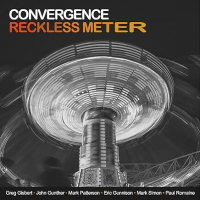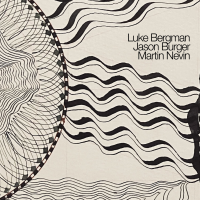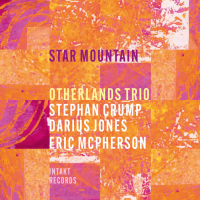Home » Jazz Articles » Extended Analysis » Marc Seales: Marc Seales: A Time, A Place, A Journey
Marc Seales: Marc Seales: A Time, A Place, A Journey
 Marc Seales
Marc Seales A Time, A Place, A Journey (Live)
Origin Records
2004
University of Washington professor Marc Seales has been an active part of the Northwest mainstream jazz scene for over thirty years. He has appeared on dozens of recordings and has worked with many players including Benny Carter, Joe Henderson, Eric Alexander, Don Lanphere, Mark Murphy and Slide Hampton.
In addition to leading his own group “New Stories” and pursuing his teaching duties at the University, Seales has been pretty much the first-call recording session pianist around the Northwest for many years. With such a strong and varied background in mainstream playing, I was surprised to see that he had put together a new and entirely different group for his latest CD, A Time, A Place, A Journey, which was recorded live at Tula’s last June.
It is a six piece group that features bass, drums, saxophone, electric guitar and keyboards plus percussionist Lary Barilleau. With the exception of the traditional song “Deep River,” all the tracks are originals by Seales. For want of a better label, this is jazz-fusion music in the truest sense of the word. Four of the seven pieces feature some astonishingly vivid electronic colorations and the remaining are all acoustic performances. There is also a lot of real improvising done here by saxophonist Mark Taylor and guitarist Fred Hamilton. The bottom end is filled out by veteran mainstream bassist, Phil Sparks.
TOUCHSTONE
The pieces range from the very vigilant sounding “Long March”, which features a rolling 6/8 drum cadence, to the strange, far-away sounding, friendly-alien vibe of “Enigma.” On this track, Seales plays soft, sustained Rhodes keyboard chords floating over drummer Steve Korn’s very fast, light, brushwork on cymbals. The over-all effect is akin to relaxing in a warm tub while listening to the pleasant rustling of ambient tree-noise coming in through your window. Continuing the nature metaphor, as the final ending chord of “Enigma” dies away, there is a wash of sound provided a by a Brazilian rain-stick which suggests a faraway jungle waterfall. All of this bears an uncanny resemblance to the CD’s cover art, which is a photo of Peru’s mysterious Machu Picchu. This then, in turn, resembles the cover art on Herbie Hancock’s 1974 classic fusion recording “Thrust.” Seales insists that the resemblance is coincidental but, never-the-less, the image makes a strong, if unintentional, connection to that touch-stone fusion recording.
My personal favorite is the opening, acoustic track entitled “Waiting.” It has a mysterious, rhythmic, two-note melody that repeats many times as it is colored and re-colored by shifting harmonies. There is an interesting, musical balancing game going on here. Since the melodic interest here is perfunctory and the bass line so sparse that is almost nonexistent, Seales relies on dark, somber, descending chord movements to carry the piece. His very clear and light touch propels the listener from a very calm beginning to a frenzied climax which draws enthusiastic applause form the audience. This kind of tune is ideal for a strong soloist, because its sparse nature allows, even re-quires, the artist to fill it up. If the previously described “Enigma” musically portrays my favorite vista from Queen Anne Hill, then “Waiting” suggests a funky, brick-walled jazz club which, of course, is exactly the kind of place this recording was made in.
There are two more acoustic tracks: “Deep River,” which is a touching rendition of the traditional hymn and “Righteous Path,” a charming, laid back, Caribbean piece.
The closing track is “This Place, At This Time” which opens and closes with some impressive ethereal, electronic sounds that one might assume could only be produced in a studio setting. The quiet ending of this piece creates a sort of electronic sigh that does bear a resemblance to certain vintage 1970s Miles Davis fusion pieces, such as “Little Church.” Back then, Davis seemed to alternate between frantic, hard-driving rock jams and surreal, spacey pieces that seemed to reflect a society both stimulated and exhausted by multiple assassinations, the first moon landing and the Viet Nam debacle. Seales’ “This Place” has both of these qualities because he inserted an energetic jam-section sandwiched in between the ethereal opening and closing sections.
There is always pressure on an improvising musician to be “good,” which often means just quoting favorite licks or practice material in order to fill a dull moment. Perhaps the strongest facet of Marc Seales playing is that he always plays “in the moment.” That is a form of musical honesty and, if one is brutally honest when improvising, it is virtually impossible to play jazz “badly.” Part of Seales’ sense of spontaneity is also reflected in the fact that he chose, after very little rehearsal, to premier and record this music in front of a live audience.
Seales resembles Herbie Hancock in that there is a certain coolness and reluctance to emote unless circum-stances have absolutely led him there. But when the muse does strike, the heavens open up and the sun bursts forth. There is always a pleasant tension in the air when Seales plays because, truly, anything may happen. Out of the three or four Northwest pianists who could be considered to be in Seales league, he alone has the emotional power and scope to pull a musical rabbit out of a hat, all without sounding practiced.
NO FUZAK
A lot of artistic and visual metaphors have been used here to describe the music on this CD, but the pieces them-selves are sound paintings. This is not just a band playing funk-junk or trying out a style to see if they can make music out of it. There is a strong, contemporary message here that flows out in a natural way. It helps that it is conveyed by seasoned players who will not let this music lapse into “smooth jazz,” or an extension of Muzak, which some like to call “Fuzak.” There are plenty of talented players like guitarists Larry Carlton and Chuck Loeb who are already covering that quite nicely.
By temporarily abandoning the comfort zone of his mainstream playing, Marc Seales had to have been going against his instincts a bit, which is the definition of a creative act. Perhaps this is why the band sounds so fresh.
It’s remarkable that Seales has held his 1970s electric-jazz roots largely in check this long, but for people who need to listen to something modern that has a brain, as well as a heart, it has been worth the wait.
~ Butch Nordal
Visit Marc Seales on the web.
Personnel
Marc Seales
pianoAlbum information
Title: Marc Seales: A Time, A Place, A Journey | Year Released: 2004 | Record Label: Origin Records
Tags
PREVIOUS / NEXT
Support All About Jazz
 All About Jazz has been a pillar of jazz since 1995, championing it as an art form and, more importantly, supporting the musicians who make it. Our enduring commitment has made "AAJ" one of the most culturally important websites of its kind, read by hundreds of thousands of fans, musicians and industry figures every month.
All About Jazz has been a pillar of jazz since 1995, championing it as an art form and, more importantly, supporting the musicians who make it. Our enduring commitment has made "AAJ" one of the most culturally important websites of its kind, read by hundreds of thousands of fans, musicians and industry figures every month.



















